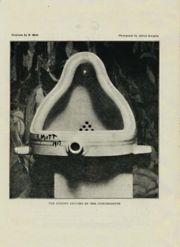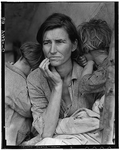
Come in, don’t be shy. Welcome to the scholars’ hell.

Come in, don’t be shy. Welcome to a place where laws are made to be broken and imagination takes its place as the dominant power in the human psyche. Toss your preformed ideals of reason and truth, for here we speak in riddle so that the truth is no longer universal, but determined by each individual who chooses to interpret our code. Take a look around what we have available for you, and if you don’t find a place you fit in, then start your own institution with your own set of rules so you can fit in. We are all equals here, and we must all help each other realize our power to rewrite all that has been presented before us. Sure you’ll be criticized, and of course not everyone will agree with you, but give it some time and I’m sure we’ll all come around eventually. Welcome to George Dickie’s “Artworld”, the open-policy realm for artists of all sorts, where the ticket to get in relies thoroughly on one’s ability to defend their reason for being there. Welcome to the scholars’ hell.
No rules, no regulations, no means of accurately describing what is appropriate
or ridiculous. No definition aside from what Dickie attempts to put forward
in his attempt to specify a generalization of the vast establishment that art
has become. According to Dickie, “a member of the artworld confers the
status of candidate for appreciation” (Dickie, 26). Can there even be
a broader notion of art than what this statement presents? Under this notion,
anything which can be observed, imagined, or created has the potential for being
conferred the status of candidacy for appreciation by any existing or potential
member of the artworld and their ideals or the ideals of a possibly new institution
through which that which has the candidacy for potential appreciation may, hypothetically
speaking, find refuge and a fan base. In other words, anything has that vague
ability to be in this artworld, as long as it has a good lawyer.
Take, for example, the highly acclaimed and much disputed piece presented by
Marcel Duchamp as a candidate for membership in the artworld in 1917, Fountain.
Nothing particularly new or astonishing to be found in this particular piece,
as it is simply a urinal placed in a museum setting, possibly the most accepted
method to have an aspiring member officially inducted into this artworld. The
piece is undeniably original in the realm of art, yet it is something which
has been seen and used in a public setting for quite some time. According to
Dickie, the fact that Duchamp made the official presentation of this “readymade”
into an art institution automatically places it as a candidate for acceptance.
Considering the focus Fountain has received in its time, the appreciation the
audience has for both the gesture and the piece would automatically place it
within the hallowed walls of the artworld institution, which it can either find
an institution which will accept Fountain, or where it will create its own place,
no longer in the hands of the artist. In this manner, there is a definite line
drawn between life and art. That which is in daily life, or are considered “readymade”,
is not art as Duchamp wished to present it, but instead a “readymade”
is art only when we choose to see it as art, thus destroying the genius in Duchamp’s
presentation of Fountain as the link between the natural world an the artworld.
Dickie’s theories go further to remove the artist’s genius and the
arts genuineness, causing the act to be essential but not important in the artworld.
When photography became a medium through which an artist can link the real world
and the artworld, Dickie’s theory of an artworld helps to remove the essential
information many photographs require to display their true brilliance. In 1936,
photographer Dorothea Lange introduced her photo “Migrant Mother”
as a potential candidate for Dickie’s artworld. What would one see if
they did not realize the story behind this picture? Is the pain in the mother’s
eyes enough to represent the true tragedy of the Great Depression, or is our
understanding needed to realize what the artists is attempting to communicate?
Do the hidden faces of the children seem more an act of shyness if we as the
audience did not realize the starvation and hardship that has caused them to
cling to their mother so? According to Dickie, none of this really matters in
the end, for it is only the photo which is being presented, and thus only the
photo which the audience must come to appreciate or ignore. If this picture,
however, was presented in a manner such that the audience dealt with starvation
on a level beyond that of this mother and her children, would it have been considered
as great a work of art as it has become in the satisfied United States of America?
Would such an audience not understand the pain in the eyes when there are clothes
on her back and healthy children at her side? Would they envy her instead of
pitying her for having shelter, however primitive? If audience is the driving
force behind a piece of art, then perhaps many great pieces would not have seen
the light of day had their initial audience not allowed the piece into their
artworld. The back story, though extraneous in some cases, are as interesting
and worthy of recognition as the actual piece itself. Dickie’s artworld
removes the art from that story like a child from its mother, to fend for itself
in the artworld institution or become lost in the process.
Every coin has a flip side, so for every piece of art that the Dickie’s
theory destroys through his emphasis on audience, there must also be a piece
which has “faked” its way into the artworld by causing a sympathetic
response, and not necessarily an aesthetic appreciation, in the audience they
must convince. An example of this would be from the BBC show, appropriately
named, “Faking It”. In one particular episode, a budding artist
attempts to make his way officially into the artworld by convincing a board
of experts that he is a genuine artist. Ironically, though, in order to convince
the board he uses terminology, empathy, and politics in order to sway their
judgment of him, not his art. To Dickie, the moment he placed his art in a frame
and hung it on the wall of a museum, his art classified for potential appreciation
and thus was already a budding member of the artworld. The fact that he created
a small fan base slightly earlier in the program would make that potential a
fact, and his art was already in the artworld, and yet he had to convince the
“experts”, who are nothing more than an audience separate from those
he swayed previously, that his art was legitimate. One critic in particular
was not so easily charmed, and spotted him for the “fake”. Had the
other members been of his mind, and had not heard the reasons beyond the art,
perhaps they would have come to the same conclusion, thus causing his art to
be rejected. It all came down to a particular audience base appreciation for
his art to be considered art, and Dickie would probably have agreed with the
means the “imposter” used to establish himself in the artworld as
it broke no “rules”. Whether or not his art would stand up in the
modern world if BBC had not done a production and increased the potential for
his art’s appreciation, there is no way to say for sure.
In this artworld, all facts behind art break apart. All manners of criticism,
every method of breaking down the aesthetic value, the examination in order
to determine purposefulness without purpose, any concern for the cathartic aspect
are no longer needed in order for a creation to transcend to the realm of art.
Theory is replaced by action in order to create a foundation for this artworld
institution. Dickie’s theories remove all that had been established before
in order to encompass everything that could be art and everything that is art.
There is no way to study what defines good art or great art, for these ideas
could be ignored in Dickie’s artworld if the art is presented to a less
educated, less logical audience. Without firm gates through which a piece of
art must effectively pass to be accepted into the artworld, this world loses
the prestige it once had as a skill, and has instead become another realm in
which politics has become the defining factor in greatness.
Marcel Duchamp, Fountain, 1917

Dorothea Lange, Migrant Mother, 1936,

by Jason-Edward McEnerney
Expected Graduation Date: May 2007
Major: Math
Hometown: Mililani, HI
The entire focus of this course seems to be educating us in the different ways
to think about art, criticize art, and even define art, not all of them being
identical to what we may have already had ingrained in our mentality concerning
art. The theory presented by Dickie was the theory of an art world, a place
I have hopefully described and discussed accurately enough in the paper above
to not merit another description here. In fact, the entire design of this assignment
was to not only criticize this particualr theory, but also to give reasons for
our thoughts in relation to art pieces as well as an art video given in class
titled "Faking It". Although there is more speculation than actual
conclusion in my paper, what is given above seemed accurate enough in fulfuilling
the required assignment to merit a spot here. Hope you can come to your own
assumptions about why, and hopefully one of them will be the correct conclusion.